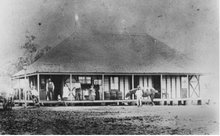One of the things I’ve been wrestling with is getting an idea of how the Queensland agents in Germany actually operated. Descriptions exist of the agents and some of the advertising material, but there are few descriptions of how recruitment worked and how the agents went about their job. There is no doubt that such agents were successful. One of the most famous agents for Queensland, J.C. Heussler (or Häußler) was personally responsible for 2000 German migrants to Queensland and did very well financially out of his position.
I have no grand insights to offer you today on Heussler and his ilk, but at the Historical Society on the weekend (doing my open afternoon shift) I was able to pick up a book on Heussler written by his great-grandson. I have not read more than the introduction, but I am hoping for some insights on operating practices. From the slightly adulatory tone of the writing I am not expecting anything too juicy though. Some family historical detail would be the best outcome for which I could hope.
I was reminded of agents, or state representatives, recently with the discussions in the news over the appointment of our immediate past premier Peter Beattie to represent Queensland in the US. While a lot of media attention was of the “jobs for the boys” tone, one article pointed out that large state delegations overseas are the historical legacy of these early migration agents. For example, Queensland still maintains a twenty-person delegation in London while many comparably-sized American states only sub-contract single local representatives to push their cases and attract trade to their states.
I have only tackled the introduction, because I have spent the day (incidently the first day of the children’s autumn holiday) on a plethora of house-related tasks. First, there was the tank guy coming to look at our downpipes and discuss efficient water-harvesting and the possibility of a new, larger water tank. Then, starting on my task for the week of tracking down 55 metres of 6 inch (old measurements for an old house) wide hoop pine tongue and groove floorboards (try saying that quickly many times). So far I’ve talked to twelve different timber purveyors – some retailers and others saw mills. It looks as if it will not be as hard a task as many suggested. If I want recycled, artistically aged boards I have to pay through the nose. But if I am satisfied with fresh, custom milled boards then we don’t have a problem. No-one is keen to deliver to Marburg though. I spent significant periods of time explaining exactly where it is along the lines of “no, not as far west as Toowoomba.”
My only issue is the thought that somewhere people are cutting down hoop pines to satisfy my desire for floorboards. I just have to get over this, or use structural floor sheeting which probably hasn’t gone anywhere near a tree. I figure that my cosmic credit is quite good at the moment, having recycled a whole house, so 55 metres of consumption won’t tip me over the edge. Spending entire days on the telephone might.
Monday, 7 April 2008
The opposite of still life
Labels:
agents,
everyday life,
history,
houses,
Johann Heussler,
migration,
Queensland
Subscribe to:
Post Comments (Atom)

No comments:
Post a Comment